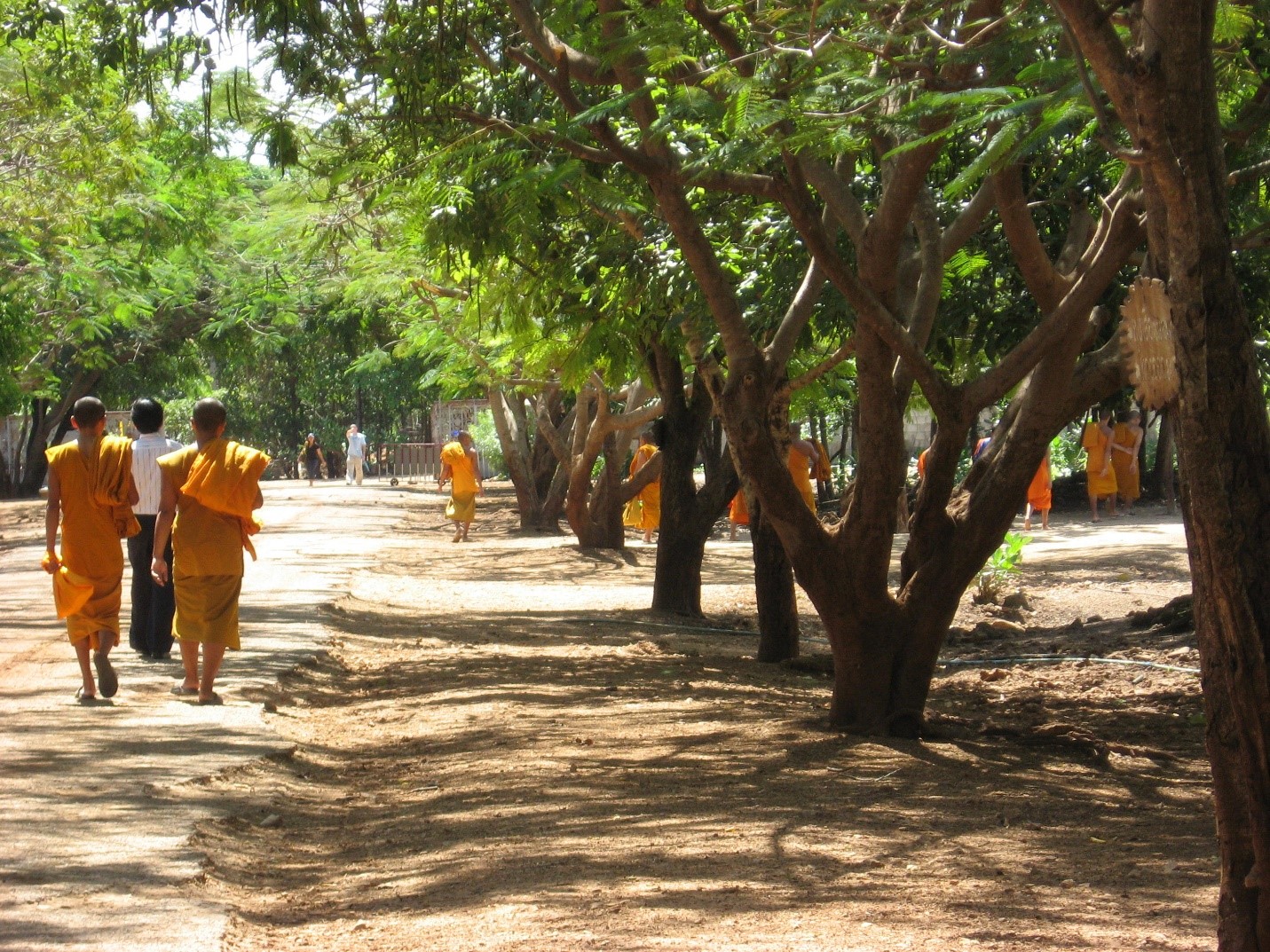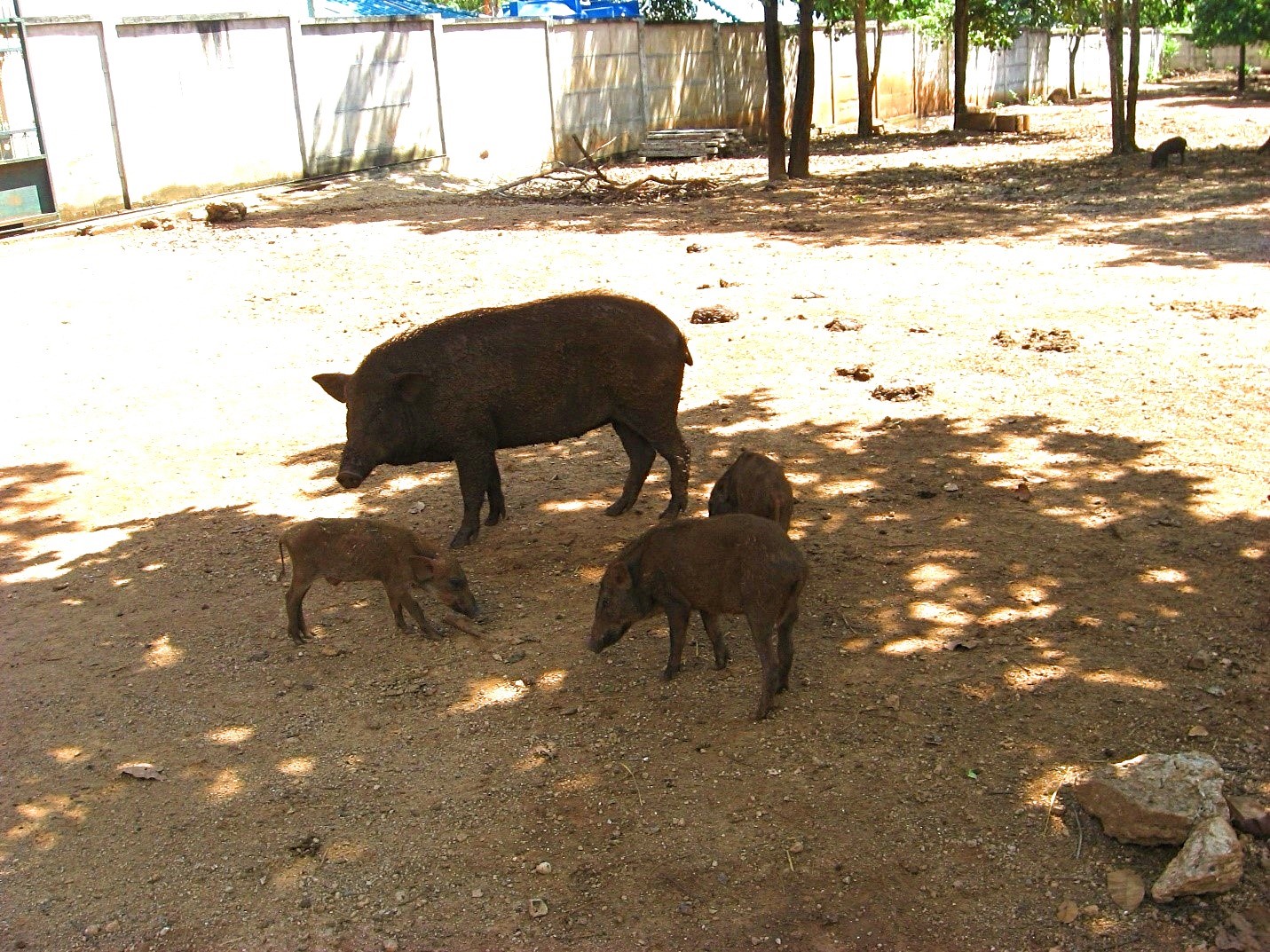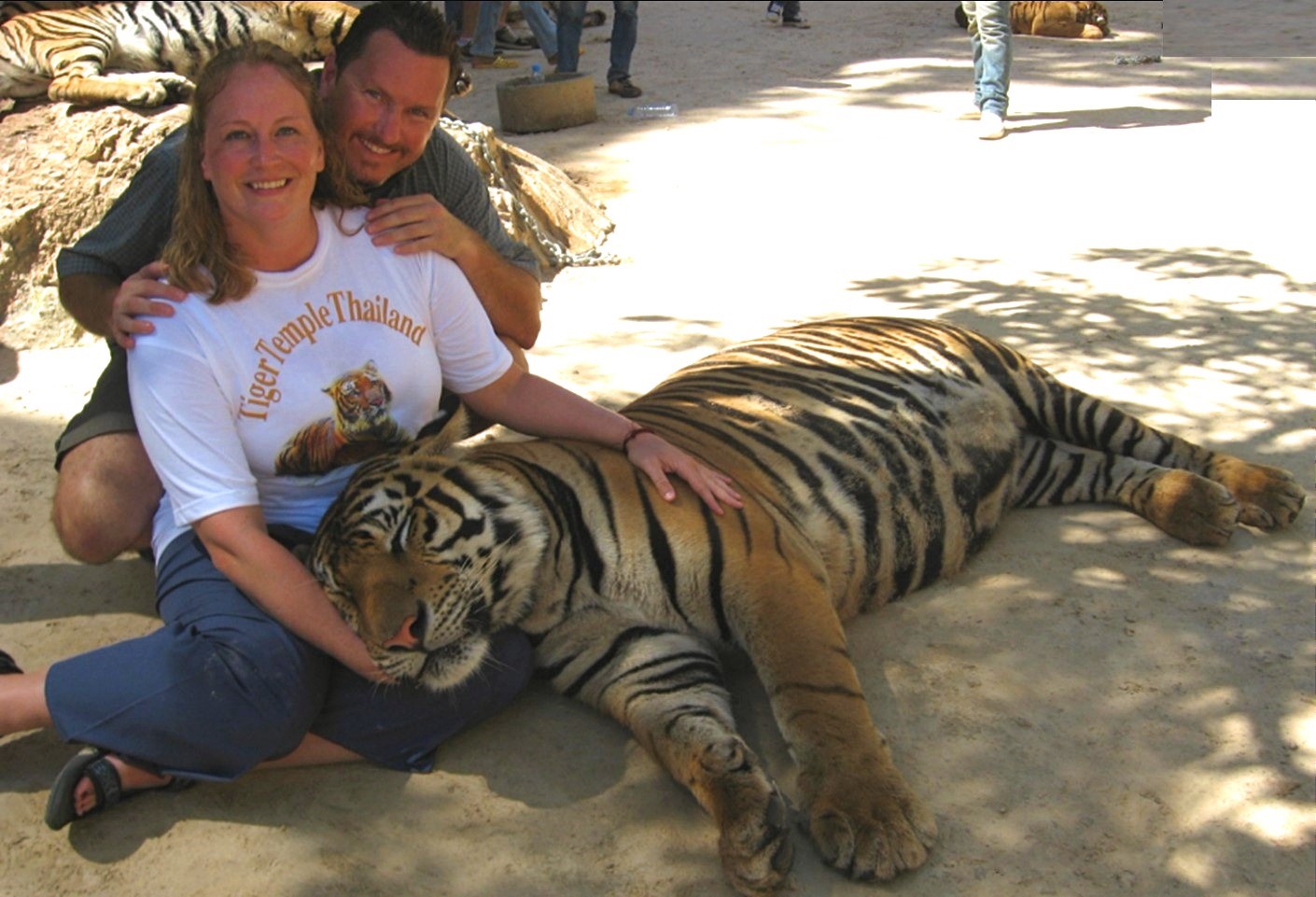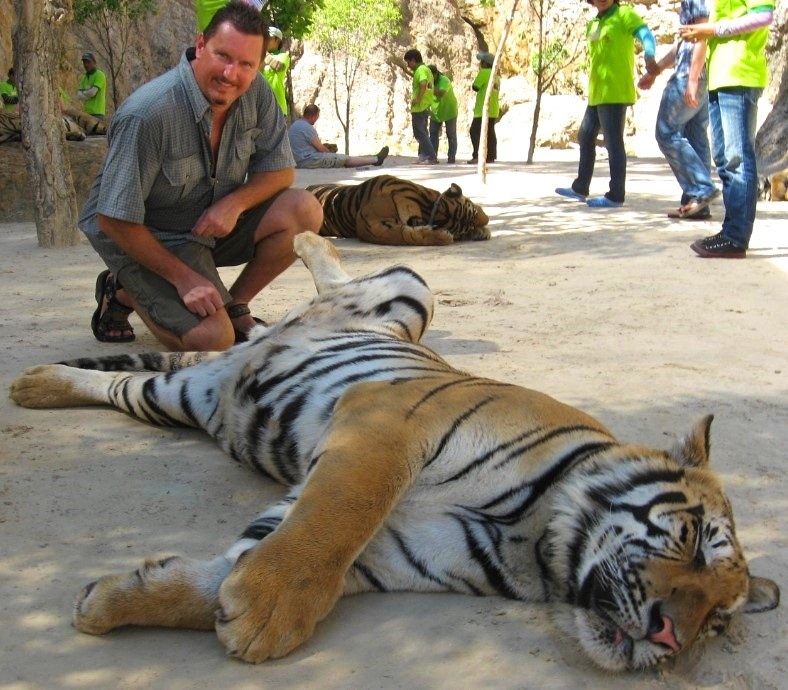Thailand Day 11 — Here Kitty Kitty Kitty
Wed Oct 22nd, Day 11 – Here Kitty Kitty Kitty
We found out a wonderful hot breakfast buffet is included in our room price. So we loaded up before setting out on a long day trip to Kanchanaburi to visit Tiger Temple.
It’s about a 3-hour ride north of Bangkok along the Myanmar (Burma) border. We made arrangements thru the hotel to have a driver take us. Tiger Temple…a.k.a. Wat Pa Luangta Bua Yannasampanno was established by a monk named Abbot Phra Acham Phusit Kanthitharao in 1994 by the order of his teacher Venerable Luangta Maha Bua Yannasampanno (the highly respected and famous meditation guru). The monastery built here was named after him. It has since gained reputation as a wildlife sanctuary.
It started with an injured jungle fowl given to a monk by villagers. Then peacocks started to come attracted by the calls of a rather large colony of jungle fowl. An injured wild boar stumbled to the monastery and the monks cared for him until he could be released back to the forest. The next day, he came back followed by his family group of about 10 animals. Yes, we saw countless wild boars and peacocks running around on the road with us while we browsed the grounds.
Villagers also started to bring in unwanted pets: four species of deer moved in, followed by buffalo, cow, horses, and wild goats. All these animals currently roam the grounds freely. The deer are quite tame and Joe and I were able to stand directly next to them and pet them.
The first tiger cub arrived in the monastery in Feb 1999. It was a female cub and she was very sick. When she was only a few months old, her mother was killed by poachers near the Thai-Burma border. The cub was sold to a wealthy Bangkok resident who ordered her stuffed. A local was hired to do the job and injected her with preservative formula and yet the cub survived. She was very sickly and terrified at the slightest sound when she arrived at the monastery. Under the monks care, she did recover although she fell seriously ill later and died. People who knew about the poaching also knew about the monks’ reputation of providing a safe haven.
Because it is still a monastery, pants are required for women. They had capris they would sell you at the entrance if you were not wearing the proper attire. Which is good because I did not have mine on so I bought a one-size-fits-all pair with a massive drawstring, cinched me up, and away we went!
The monastery is situated in Kanchanaburi province just next to Myanmar (Burma). The Western Forest Complex that stretches along this border is said to be the largest protected area in Asia and also believed to be the largest surviving tiger population in the region. And yet, poaching still occurs in this protected area. A Thai poacher can get up to $5,800 for killing a tiger, which is several years’ salary for a farmer. And when the mother is killed, the cubs are taken as a bonus or left to fend for themselves in the jungle.
Just a few weeks after the first cub died, 2 cubs taken from poachers were brought to the monastery and then 2 more were brought. Monk Abbot welcomed the animals and even though he had no previous experience in taking care of tigers, he learned on the job. As years went by, the tigers grew up and started reproducing. As early as 2003, Abbot conceived an idea to build an open-air enclosure where each tiger would be given 1 rai of land.
We got to play with the tiger cubs….well, they are actually too frisky to actually “play” with them. Their claws and teeth are incredibly sharp so we can’t get too involved with the ones that are playing aggressively. However, we got to pet them. They just got a batch of new cubs who are only 16 days old. You can go and volunteer for a month at a time at the sanctuary.
We met this kid named Rod from Canada. He’s been working with the tigers for 7 years now; his first year he was a monk. He told us they stopped filing down their claws because sometimes the tigers would come up and bear hug you and their claws dig in your back. When they would pull away, dull/filed down claws would take out much more skin than sharp claws, which would make a clean cut.
He wanted us to come back the next morning for a special 90-minute outing with the tigers where you could swim and eat breakfast with them. Wish I had known this before our visit! They eat cooked chicken (anything raw has active living organisms which would go against the monks belief to feed something living to the tigers).
We got to sit and hold the BIG tigers. The staff takes you in one at a time. That way if one would act up, the workers don’t have to decide who to protect (me or Joe). And they ask that you not wear the colors red, pink or orange as they make the tigers more aggressive.
Most cat species sleep during the heat of the day. Just like a housecat takes its nap in the afternoon; so do the tigers. They are a lot more active in early morning or evenings when the temps cool down. They have special exercise time down in the canyon then. All of the tigers have been hand-raised and imprinted to humans and therefore have no fear of people. The “fierce” behavior often associated with captive tigers is caused by placing wild animals in stressful conditions in a captive environment. These tigers are handled at a very early age and thus have become desensitized to being touched by people. This is why they are able to sleep while people sit next to them for photos. I’m sure they would not be this docile later on when they become more active.
The big cats were quite heavy. Their heads were massive and they were very hot. Their fur was bristly and coarse; not soft like a housecat. I would imagine their thick coat protects them extremely well from the elements.
Besides having tigers, wild boars and peacocks, they also have a meditation practice where people can participate (you must wear white clothing and women must be accompanied by a man so they can communicate with the monks). They also have a large Buddha statue made from 80kg of gold you can view.
The very first male tiger that was brought to the sanctuary has his own fancy enclosure. We went up to see him and he was roaring up a storm. I suddenly look to my left and that tiger must have got a nearby wild boar all riled up because here is this wild boar staring us down snorting like he was going to charge us or something. We quickly moved on. I don’t know what he was going to do but the look in his eye didn’t seem friendly.
We were pretty tired from our all-day excursion so we caught a movie at the nearby mall for our evening entertainment. Their movies are a great deal. Even the VIP tix we bought are still $3 less than a movie in a theater back home. VIP gets you into the red velvet reclining chairs where you only sit next to one person. The chairs are in groups of 2 so I only was sitting next to Joe. They also give you blankets to cover up with and let you order food. They keep the temperature in there like a meat locker so I was glad for the blankets. A large popcorn was only $1.
Now I realize that theaters with luxury reclining chairs are nothing new in the U.S. these days BUT this trip was back in 2008. And back then, we did not have those kinds of theaters in Des Moines at all so this was a special treat for us at that particular time.
Otherwise, the only other thing that seemed different is before every movie, the national anthem is played and you must stand to show respect to the King. The movie theater showed clips of the King’s life and all his humanitarian work with the people so that was kinda neat to see. We saw Body of Lies with Leonardo DiCaprio and yes it was in English. There were other movies offered that were in Thai. It’s so hilarious, they have a movie coming out that looks like the Thai knockoff version of Pirates of the Caribbean. Even the Thai actors looked very similar to Orlando Bloom and Johnny Depp.
2018 Update: Due to allegations of wildlife trafficking, in 2016 the government raided the monastery and seized 137 tigers.
It was determined some tigers were being speed-bred where they take newborn cubs from their mothers quickly after birth so the mothers could reproduce another litter. This violated government orders that the temple neither breed nor profit from the tigers. More allegations surfaced that the monks were illegally trading tigers. Former staff and volunteers provided details of missing adults and cubs. This was confirmed because they had been microchipped and registered with the government and were therefore traceable.
The raid also produced a horrific discovery in the freezer: 40 dead cubs and 20 more cubs floating in jars of formaldehyde, tiger pelts and tiger skin amulets; and other wildlife products. Yes, I have seen terrible photos from the raid of the carcasses they found as well as the jars the cubs were floating in and the images are just too disturbing to post here. My heart broke when I saw it.
It’s well known that tiger skins, bones, teeth and claws are a valuable commodity in illegal wildlife trade across the world producing some $19 billion a year. Due to their endangered species, tigers are protected under both Thai law and an international treaty governing cross-border trade of these endangered species.
Investigations into alleged wildlife trafficking at the Tiger Temple continue. Meanwhile government efforts have been made to strengthen protocols and regulations to better monitor captive animal facilities and prosecute those who violate these laws.
The tigers seized from the Tiger Temple are living in government wildlife centers. The mothers no longer are having back-to-back litters and the tigers are now safe.
Recently Four Paws, an animal welfare group based in Austria, contacted the wildlife department to propose construction of a big cat sanctuary that could house 200 animals. Four Paws would help design and build this sanctuary on government land. This sanctuary would allow the Tiger Temple’s animals as well as other confiscated cats to live out their remaining days under more humane circumstances, giving them much more room to roam.
At the time of our visit, it was such a unique experience but I feel sick thinking about what was happening to the tigers behind closed doors. I wanted so much to believe those monks were doing something good rescuing those tigers from the poachers. I love animals especially cats. I feel very naïve now. Something that started with benevolent intentions quickly transformed under greed. I wish the end of today’s blog had a happier tone but sometimes these are the revelations in life. Mostly, I’m so relieved these magnificent animals were rescued and are now safe.
Tomorrow on Day 12 we will take a city tour of the temples in Bangkok.









